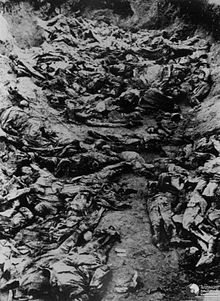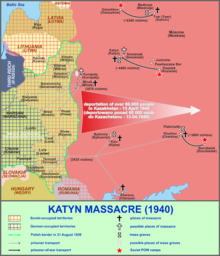
Back Slagting van Katyn Afrikaans مجزرة كاتين Arabic Katın qırğını Azerbaijani Катынь енәйәте Bashkir Катынскі расстрэл Byelorussian Катынскі расстрэл BE-X-OLD Катинско клане Bulgarian কাতিন গণহত্যা Bengali/Bangla Lazhadeg Katyn Breton Katinjski masakr BS
54°46′20″N 31°47′24″E / 54.77222°N 31.79000°E
| Katyn massacre | |
|---|---|
| Part of the aftermath of the Soviet invasion of Poland (during World War II) and Soviet repressions of Poles | |
 Mass grave of Polish officers in Katyn Forest, exhumed by Germany in 1943 | |
| Location | Katyn Forest, Kalinin and Kharkiv prisons in Soviet Union |
| Date | April–May 1940 |
| Target | Poles (military officers, intelligentsia, and prisoners of war) |
Attack type | War crime, decapitation, massacre |
| Deaths | 21,857[1] |
| Perpetrator | NKVD |

The Katyn massacre[a] was a series of mass executions of nearly 22,000 defenceless Polish military and police officers, border guards, and intelligentsia prisoners of war carried out by the Soviet Union, specifically the NKVD (the Soviet secret police), at Stalin's order in April and May 1940. Though the killings also occurred in the Kalinin and Kharkiv NKVD prisons and elsewhere, the massacre is named after the Katyn forest, where some of the mass graves were first discovered by German Nazi forces.[2]
The massacre is qualified as a crime against humanity,[3] crime against peace,[4] war crime[5][6] and Communist crime[7] and according to a resolution of the Polish parliament or Sejm, it bears the hallmarks of a genocide.[8]
The order to execute captive members of the Polish officer corps was secretly issued by the Soviet Politburo led by Joseph Stalin.[9] Of the total killed, about 8,000 were officers imprisoned during the 1939 Soviet invasion of Poland, another 6,000 were police officers, and the remaining 8,000 were Polish intelligentsia the Soviets deemed to be "intelligence agents and gendarmes, spies and saboteurs, former landowners, factory owners and officials".[10] The Polish Army officer class was representative of the multi-ethnic Polish state; the murdered included ethnic Poles, Ukrainians, Belarusians, and 700–900 Polish Jews.[11]
The government of Nazi Germany announced the discovery of mass graves in the Katyn Forest in April 1943.[12] Stalin severed diplomatic relations with the London-based Polish government-in-exile when it asked for an investigation by the International Committee of the Red Cross.[13] After the Vistula–Oder offensive where the mass graves fell into Soviet control, the Soviet Union claimed the Nazis had killed the victims, and it continued to deny responsibility for the massacres until 1990, when it officially acknowledged and condemned the killings by the NKVD, as well as the subsequent cover-up by the Soviet government.
An investigation conducted by the office of the prosecutors general of the Soviet Union (1990–1991) and the Russian Federation (1991–2004) confirmed Soviet responsibility for the massacres, but refused to classify this action as a war crime or as an act of mass murder. The investigation was closed on the grounds that the perpetrators were dead, and since the Russian government would not classify the dead as victims of the Great Purge, formal posthumous rehabilitation was deemed inapplicable. In November 2010, hoping to improve relations with Poland, the Russian State Duma approved a declaration condemning Stalin and other Soviet officials for ordering the massacre. However, with the Russo-Ukrainian War, the relations became strained. In 2021, the Russian Ministry of Culture downgraded the memorial complex at Katyn on its Register of Sites of Cultural Heritage from a place of federal to one of only regional importance.[14]
- ^ Gurianov, Aleksander, ed. (2015). Ubity v Katyni. Kniga pamiati Polskikh voennoplennykh - uznikov Kozelskogo lagera NKVD, rasstrelannykh po resheniyu Politbiuro TsK VKP(b) ot 5 Marta 1940 Goda Убиты в Катыни. Книга памяти польских военнопленных - узников Козельского лагеря НКВД, расстрелянных по решению Политбюро ЦК ВКП(б) от 5 марта 1940 года [Those Killed in Katyn. The Memorial Book of Polish Prisoners of War - Prisoners of the Kozelsk NKVD Camp, Shot Dead at the Order of the Central Committee of the Bolshevic Communist Party from 5 March 1940 Onwards] (PDF) (in Russian). Moscow: Memorial. p. 68. ISBN 978-5-78700-123-5.
- ^ "The Katyn Massacre – Mechanisms of Genocide". Warsaw Institute. 18 May 2020. Retrieved 11 April 2024.
- ^ "Case of Janowiec and Others v. Russia. Judgement. Strasbourg 21 October 2013". hudoc.echr.coe.int. 2013. Retrieved 20 June 2024.
- ^ "Case of Janowiec and Others v. Russia. Judgement. Strasbourg 21 October 2013". hudoc.echr.coe.int. 2013. Retrieved 20 June 2024.
- ^ "Case of Janowiec and Others v. Russia. Judgement. Strasbourg 21 October 2013". hudoc.echr.coe.int. 2013. Retrieved 20 June 2024.
- ^ "Katyń można traktować jako zbrodnię wojenną – Europejski Trybunał Praw Człowieka" [Katyn Can be Regarded as a War Crime - The European Court of Human Rights] (in Polish). TVN24. 16 April 2012. Archived from the original on 17 July 2022. Retrieved 20 June 2024.
- ^ The Polish Parliament or Sejm (2023). "Dziennik Ustaw Rzeczypospolitej Polskiej. Warszawa, dnia 13 stycznia 2023 r." [Journal of Laws of the Republic of Poland. Warsaw, January 13, 2023. No 102] (PDF). isap.sejm.gov.pl. Retrieved 20 June 2024.
(English translation) Art. 2. 1. Communist crimes, as understood by the Law, are acts committed by officers of a Communist state from 8 November 1917 to 31 July 1990, involving repressions or other forms of the violation of human rights used against individuals or population groups or in connection with their use, constituting crimes under the Polish penal law in force at the time they were committed.
- ^ The Polish Parliament or Sejm (2009). "Uchwała Sejmu Rzeczypospolitej Polskiej z dnia 23 września 2009 r. upamiętniająca agresję Związku Radzieckiego na Polskę 17 września 1939 r." [Resolution of the Sejm [Parliament] of the Republic of Poland of September 23, 2009, Commemorating the Aggression of the Soviet Union on Poland on 17 September 1939] (PDF). isap.sejm.gov.pl. Retrieved 20 June 2024.
(English translation) Long is the list of the crimes and misfortunes which befell the eastern regions of the Second Polish Republic and the Polish citizens who happened to be there. It comprises the war crime of shooting more than 20,000 defenseless prisoners by the NKVD, Polish officers; the displacement of hundreds of thousands of citizens of the Republic of Poland; placing them in inhumane conditions in camps and prisons and forcing them to do slave labour. ... The organization of the system, the persistence and scale of the phenomenon give these crimes, including the Katyn Massacre, the hallmarks of genocide.
- ^ Cite error: The named reference
Brown2009-140was invoked but never defined (see the help page). - ^ Cite error: The named reference
ipn_eng_news_high_katyn_decisionwas invoked but never defined (see the help page). - ^ Cite error: The named reference
controversywas invoked but never defined (see the help page). - ^ Cite error: The named reference
Engelwas invoked but never defined (see the help page). - ^ Cite error: The named reference
LeslieLeslie1983was invoked but never defined (see the help page). - ^ "The Katyn memorial complex", Russia's Necropolis of Terror and the Gulag Archived 22 November 2021 at the Wayback Machine.
Cite error: There are <ref group=lower-alpha> tags or {{efn}} templates on this page, but the references will not show without a {{reflist|group=lower-alpha}} template or {{notelist}} template (see the help page).
